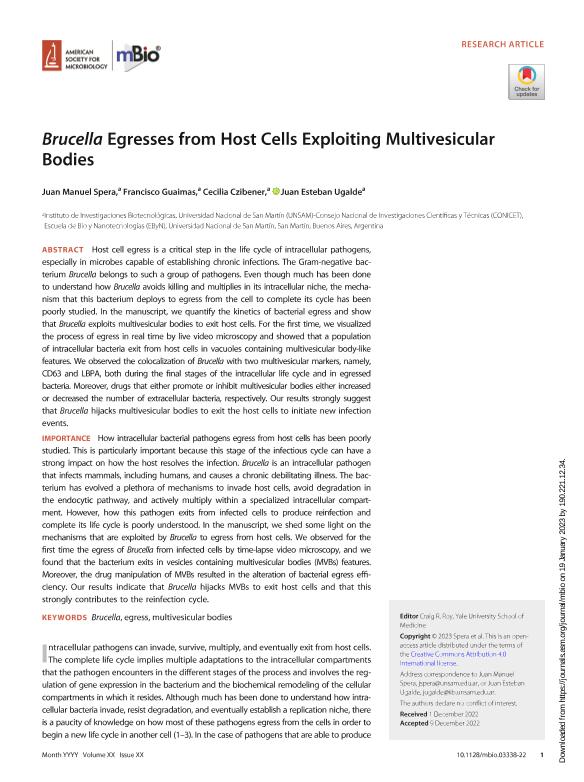Mostrar el registro sencillo del ítem
dc.contributor.author
Spera, Juan Manuel

dc.contributor.author
Guaimas, Francisco Fernando

dc.contributor.author
Czibener, Cecilia

dc.contributor.author
Ugalde, Juan Esteban

dc.date.available
2024-02-28T12:03:40Z
dc.date.issued
2023-01
dc.identifier.citation
Spera, Juan Manuel; Guaimas, Francisco Fernando; Czibener, Cecilia; Ugalde, Juan Esteban; Brucella egresses from infected cells exploiting multivesicular bodies; American Society for Microbiology; mBio; 14; 1; 1-2023; 1-10
dc.identifier.issn
2150-7511
dc.identifier.uri
http://hdl.handle.net/11336/228732
dc.description.abstract
Host cell egress is a critical step in the life cycle of intracellular pathogens, especially in microbes capable of establishing chronic infections. The Gram-negative bacterium Brucella belongs to such a group of pathogens. Even though much has been done to understand how Brucella avoids killing and multiplies in its intracellular niche, the mechanism that this bacterium deploys to egress from the cell to complete its cycle has been poorly studied. In the manuscript, we quantify the kinetics of bacterial egress and show that Brucella exploits multivesicular bodies to exit host cells. For the first time, we visualized the process of egress in real time by live video microscopy and showed that a population of intracellular bacteria exit from host cells in vacuoles containing multivesicular body-like features. We observed the colocalization of Brucella with two multivesicular markers, namely, CD63 and LBPA, both during the final stages of the intracellular life cycle and in egressed bacteria. Moreover, drugs that either promote or inhibit multivesicular bodies either increased or decreased the number of extracellular bacteria, respectively. Our results strongly suggest that Brucella hijacks multivesicular bodies to exit the host cells to initiate new infection events.
dc.format
application/pdf
dc.language.iso
eng
dc.publisher
American Society for Microbiology

dc.rights
info:eu-repo/semantics/openAccess
dc.rights.uri
https://creativecommons.org/licenses/by-nc-sa/2.5/ar/
dc.subject
BRUCELLA
dc.subject
EGRESS
dc.subject
MULTIVESICULAR BODIES
dc.subject.classification
Bioquímica y Biología Molecular

dc.subject.classification
Ciencias Biológicas

dc.subject.classification
CIENCIAS NATURALES Y EXACTAS

dc.title
Brucella egresses from infected cells exploiting multivesicular bodies
dc.type
info:eu-repo/semantics/article
dc.type
info:ar-repo/semantics/artículo
dc.type
info:eu-repo/semantics/publishedVersion
dc.date.updated
2024-02-28T10:34:24Z
dc.journal.volume
14
dc.journal.number
1
dc.journal.pagination
1-10
dc.journal.pais
Estados Unidos

dc.journal.ciudad
washington
dc.description.fil
Fil: Spera, Juan Manuel. Universidad Nacional de San Martín. Instituto de Investigaciones Biotecnológicas. - Consejo Nacional de Investigaciones Científicas y Técnicas. Oficina de Coordinación Administrativa Parque Centenario. Instituto de Investigaciones Biotecnológicas; Argentina
dc.description.fil
Fil: Guaimas, Francisco Fernando. Universidad Nacional de San Martín. Instituto de Investigaciones Biotecnológicas. - Consejo Nacional de Investigaciones Científicas y Técnicas. Oficina de Coordinación Administrativa Parque Centenario. Instituto de Investigaciones Biotecnológicas; Argentina
dc.description.fil
Fil: Czibener, Cecilia. Universidad Nacional de San Martín. Instituto de Investigaciones Biotecnológicas. - Consejo Nacional de Investigaciones Científicas y Técnicas. Oficina de Coordinación Administrativa Parque Centenario. Instituto de Investigaciones Biotecnológicas; Argentina
dc.description.fil
Fil: Ugalde, Juan Esteban. Universidad Nacional de San Martín. Instituto de Investigaciones Biotecnológicas. - Consejo Nacional de Investigaciones Científicas y Técnicas. Oficina de Coordinación Administrativa Parque Centenario. Instituto de Investigaciones Biotecnológicas; Argentina
dc.journal.title
mBio
dc.relation.alternativeid
info:eu-repo/semantics/altIdentifier/url/https://journals.asm.org/doi/pdf/10.1128/mbio.03338-22
dc.relation.alternativeid
info:eu-repo/semantics/altIdentifier/doi/http://dx.doi.org/10.1128/mbio.03338-22
Archivos asociados
